Dolly panicle hydrangea - secrets of abundant and long flowering
"A vessel of water" is the Greek name for hydrangea. This beautiful plant was brought from the island of Mauritius in the eighteenth century. Since then, it has spread throughout Europe and Asia, conquering the alleys of palace gardens and flower beds of ordinary townspeople. One of the latest innovations in the world of decorative floriculture is the spectacular Dolly panicle hydrangea.
- general characteristics
- Landing features
- Timing
- Seat selection
- Preparation of planting material
- Landing technology
- Basic rules of content
- Watering mode
- Top dressing
- Care features
- During flowering
- In a dormant period
- Preparing for winter
- Reproduction
- Cuttings
- Layers
- Dividing the bush
- Diseases and pests
- Landscape use
- Variety reviews
- Useful videos
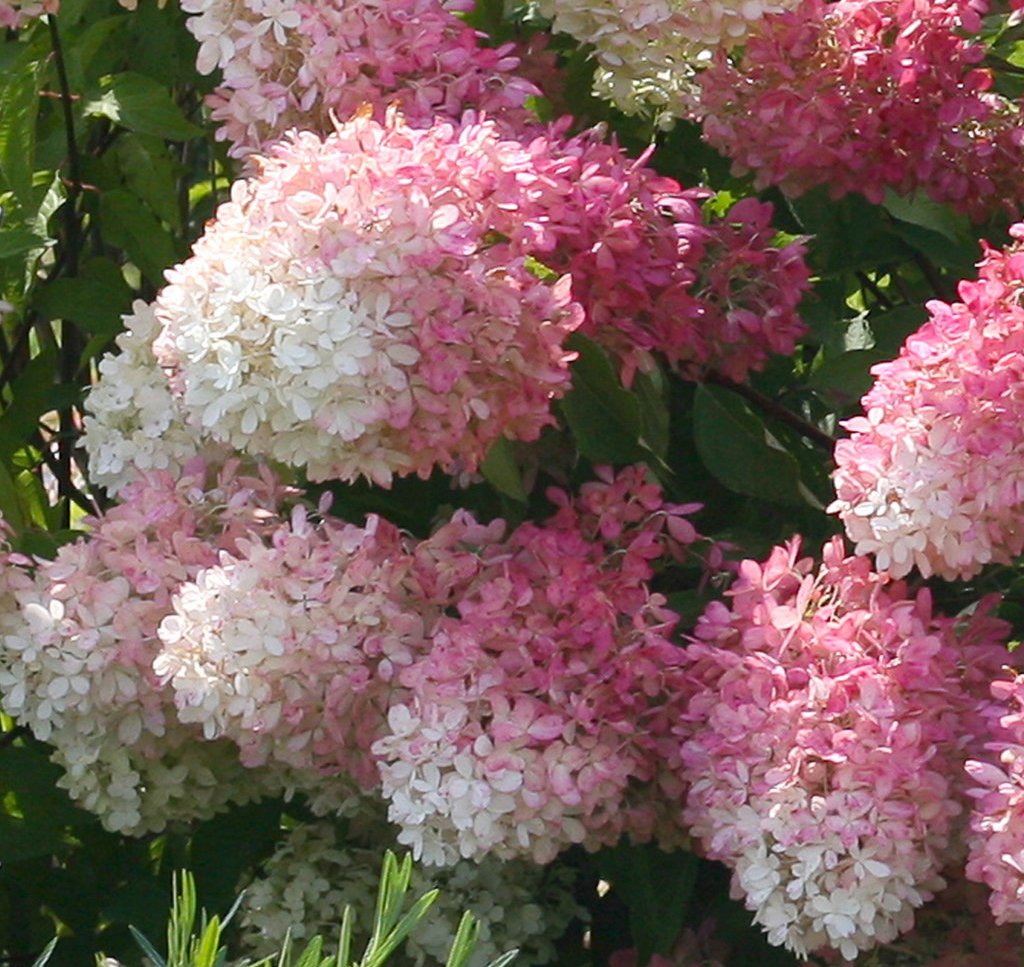
Dolly paniculata hydrangea
general characteristics
Hydrangea grows in the wild mainly in China and Japan. Three main types are cultivated in the Russian regions:
- curly (liana);
- large-leaved;
- paniculate.
The panicle variety (Hydrangea paniculata) is most adapted to the conditions of the middle zone and requires minimal maintenance. It became famous in Europe around 1830 when the German physician and naturalist Philip Franz von Siebold discovered it while in Japan.
Dolly bushes reach a height of 1.5 m, the diameter of a spherical crown is about 120 cm. Large dense inflorescences consist of small flowers, each of which has four petals. The length of the cone-shaped panicle inflorescences is 15-25 cm. They grow on strong shoots of the current year.
The initial color of the flowers is white, then it becomes cream, over time - pale pink and wine red. All this is set off by the luscious green foliage. Flowering continues from the second half of summer until frost.
Dolly is a bit like the classic Pinky Winky, but compares favorably with it:
- dense inflorescences;
- early onset and longer flowering;
- the absence of interruptions in the formation of buds, no matter how severe the winter is;
- better resistance to rain and drought.
Landing features
Timing
The best time to plant hydrangeas is spring, when the soil warms up and the threat of night frosts is over. You can plant the plant in winter. In order for the bush to take root, this is done no later than mid-autumn.
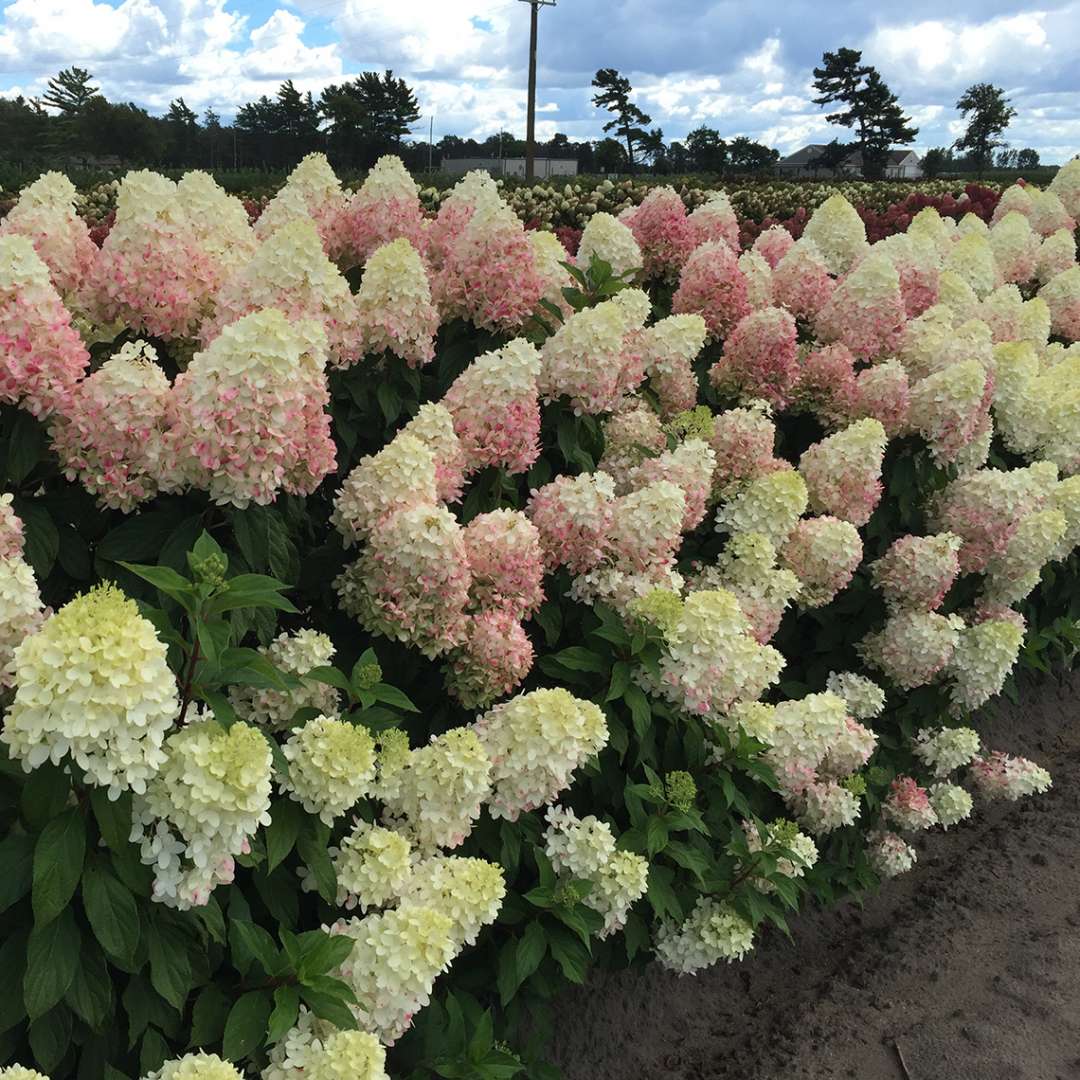
Hydrangea dolly paniculata reviews
Seat selection
Most of all, places in partial shade are suitable for shrubs. These can be areas along fences or walls of the house, with protection from drafts. Hydrangeas have evolved to adapt to acidic soils (pH 5.5 - 7.0).
The more acidic the soil, the more blueness there will be in the flower. On pure heather land, Dolly will give out blue panicles with white and pink transitions!
Lime soil is completely unsuitable for them. On alkaline soils, hydrangeas may not bloom, and at a pH above 8.0, they may die. Before planting, the site must be carefully dug up, removing all weeds.
It is advisable not to plant a flower in the immediate vicinity of fruit trees, which will emerge victorious in the struggle for soil moisture.
Preparation of planting material
For planting, it is optimal to use seedlings in containers with a closed root system. Immediately before rooting, you must make sure that there are no diseases and pests that manifest themselves:
- cobweb;
- clutches of eggs;
- thickening on leaves and trunks;
- sticky bloom on the plant;
- putrid smell;
- mold.
Landing technology
Before planting, the container with the seedling is soaked in water until air bubbles stop emerging from the soil. The size of the planting hole is 30 cm deep and about 50 cm in diameter.
The plant is moisture-loving, but on heavy soils, in order to prevent moisture stagnation (which is fraught with fungal diseases), they create a drainage cushion. To do this, a layer of expanded clay is poured onto the bottom of the pit.
To provide the necessary acidity of the substrate, peat should be its basis. On clayey soils, any organic matter (manure, humus) will always be useful to improve the structure of the soil.
Before planting, the hole is spilled with water. The soil is covered in small portions with simultaneous compaction. Internal voids are unacceptable here.
It is important that the root collar of the bush is at ground level, and its further subsidence should not be allowed. Mulching the soil around the seedling helps retain moisture and inhibits weed growth. Pine bark, coniferous litter or spruce branches are used as mulch.
If you bury iron cans in a planting hole, the hydrangea will give out blue flowers.
Basic rules of content
Hydrangeas are not capricious and need minimal maintenance. Regular and correct hydration is important.
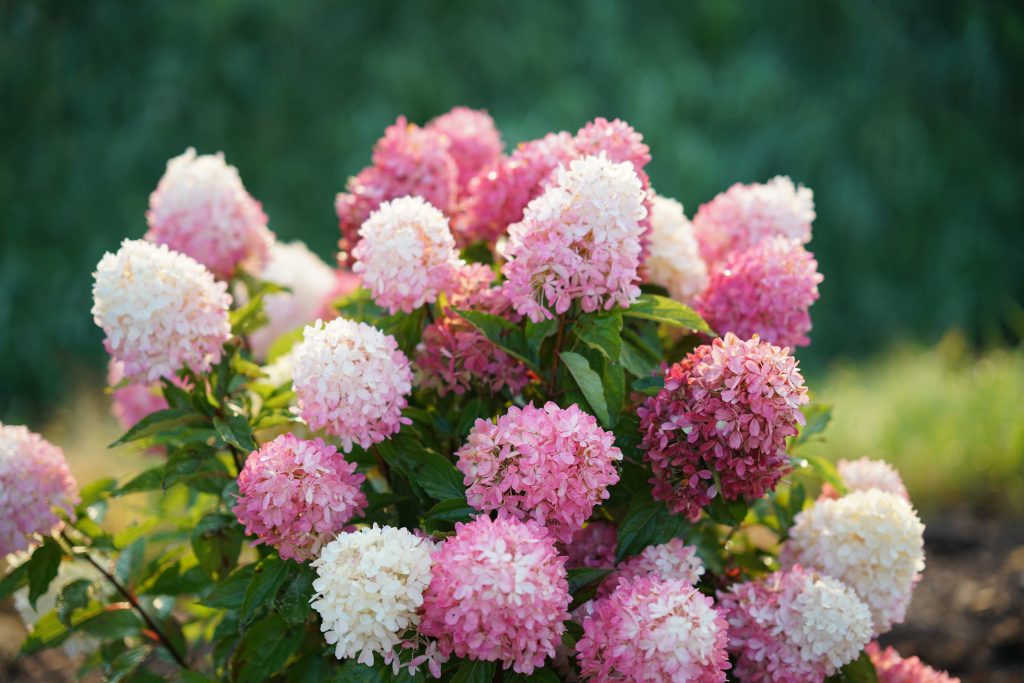
Hydrangea dolly description and photo
Watering mode
The need for watering is determined primarily by weather conditions. Hydrangeas love water, but constant excessive moisture, especially at low temperatures, can provoke fungal diseases. Water it when the topsoil dries up by 1-2 cm, but the leaves have not yet begun to fade.
After the procedure, you need to weed and loosen the soil.
Dolly can withstand a short drought, but as soon as the leaves begin to wilt, she needs abundant moisture, at least 8-10 liters per plant. If this is not done, the flower can shed its buds and "dry" the panicles.
Top dressing
Any plant needs three basic elements for its growth and development: nitrogen, phosphorus and potassium (NPK). Organic residues in the soil are not able to fully meet this need - they only improve the structure of the soil.
This problem is easily solved by using a mineral complex of the complete composition of NPK. A single dose of this tuk is 20 g (matchbox) per 1 m² of land.
Three dressings are enough per season:
- at the beginning of the growing season - with a high nitrogen content;
- in the middle of summer, at the beginning of flowering, with a predominance of phosphorus;
- in September to prepare for winter. In the latter case, nitrogen, which provokes the growth of green mass, should be excluded from the mineral composition, and the dose of potassium should be increased.
For lush flowering, water the hydrangea 3-4 times per season with acidified water with vinegar, citric acid, milk whey.
Care features
During flowering
Before flowering, it is necessary to prune the bushes and remove all weak and damaged shoots. Dolly forms inflorescences on the stems of the current year, therefore, an early procedure stimulates the development of large inflorescences and prolonged flowering. At this time, it is important to follow the watering rules.

Hydrangea dolly description and photo and description
In a dormant period
Sanitary pruning of bushes is carried out in early spring, before the start of sap flow. Remove old, damaged and diseased shoots.
Preparing for winter
Hydrangea Dolly is a winter-hardy variety that can withstand frosts down to -35 ° C. Before wintering, all panicles and excess shoots are cut off from the plants, leaving only the strongest branches.
Before the onset of cold weather, it is necessary to carry out:
- water charging irrigation;
- hilling and mulching of the trunk circle;
- construction of additional shelters for young plants. For this, frames and spruce branches or non-woven material are used.
Dolly adults do not need winter protection.
Reproduction
The main breeding method is vegetative. It is used successfully in the wild and in breeders' greenhouses. Plants retain all the qualities of the mother.
Hydrangea is the symbolic flower of Brittany. She paints the old stones and slate roofs of the region with her white, pink, blue, purple flowers.
Cuttings
This is the most popular breeding method.
- In early spring, before the start of sap flow, lignified branches of the previous year are taken.
- In summer, only green shoots of the current year are used.
Operation algorithm:
- cuttings are cut, each of which should have two internodes;
- the lower leaves are removed, the leaf plates of the upper ones are cut in half to reduce moisture evaporation;
- the lower cut of the cutting is made oblique, the upper cut is straight;
- the cutting is soaked in Kornevin's solution to stimulate root formation;
- planted in a container filled with a mixture of peat and river sand;
- cover with a cut plastic bottle or jar on top, creating a microstep.
Further, it is necessary to ventilate the sprout daily, while maintaining high humidity at the same time.
The rooting process takes about three weeks. You can plant a plant in a permanent place only next year. For its wintering, it is optimal to use a cellar or basement. Any room with approximately freezing temperatures will do.
Layers
This method ensures the production of strong, viable young plants. The middle of the lateral shoot is freed from the leaves and added dropwise using metal brackets. In the future, this part is kept constantly wet. The top of the stem is tied to a vertical peg. The next year, the stepson is separated from the mother plant and planted separately.
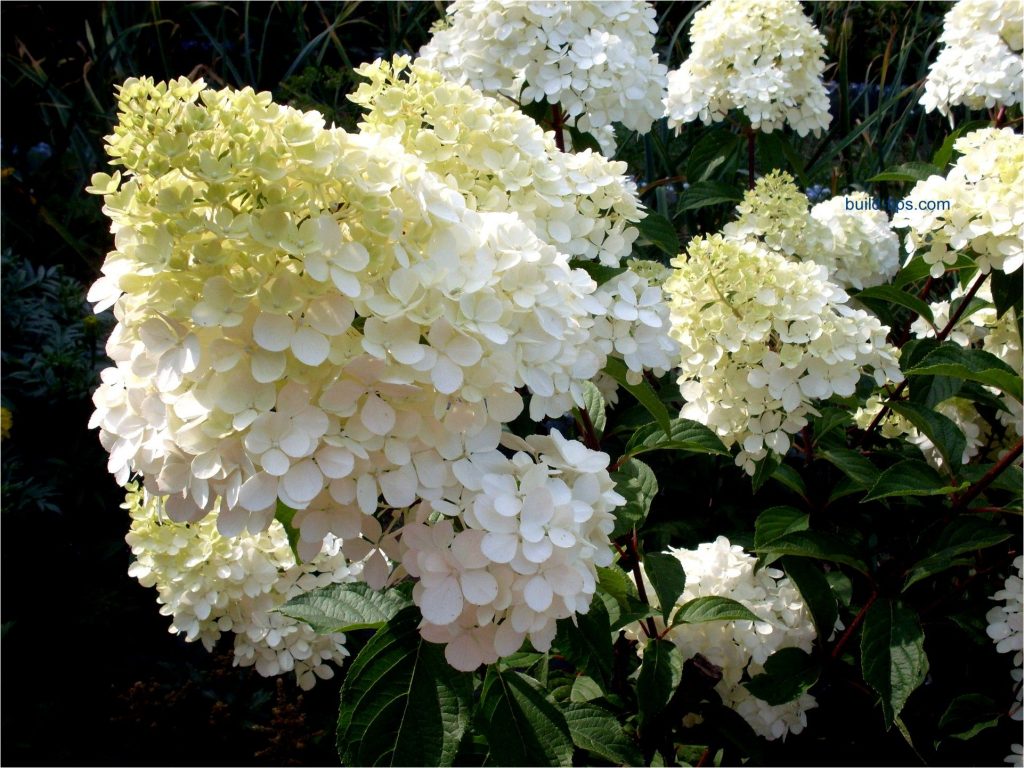
Hydrangea paniculata dolly photo
Dividing the bush
The hydrangea bush can be dug up and divided into parts by planting them separately. This is done in early spring before the beginning of the growing season or in the fall a month before the onset of constant cold weather. Having the skills, they separate part of the bush without digging it out entirely.
Hydrangea is a long-lived shrub. In the literature there is information about plants at the age of 60 years. Dolly's breeders guarantee its active flowering for 40 years with proper care.
Diseases and pests
The main danger for this garden plant is represented by fungal diseases:
- white bloom on the leaves will indicate powdery mildew;
- brown spots indicate the presence of gray rot.
The main means of fighting fungi are fungicides. And here in the first place is the copper-bearing Bordeaux liquid. Modern biofungicides such as phytosporin are also effective.
Another danger is posed by insect pests. They not only damage the plant, but also carry viral diseases. Insecticides make it easy to fight this scourge. The main thing here is to notice the problem in time.
Landscape use
In front gardens, Dolly hydrangeas look great both alone and in group plantings. Together with shrubs, they are used in mixborders. Beautiful combinations form with bamboo, herbs and other penumbra crops: hosta, astilba, ferns or autumn anemones.
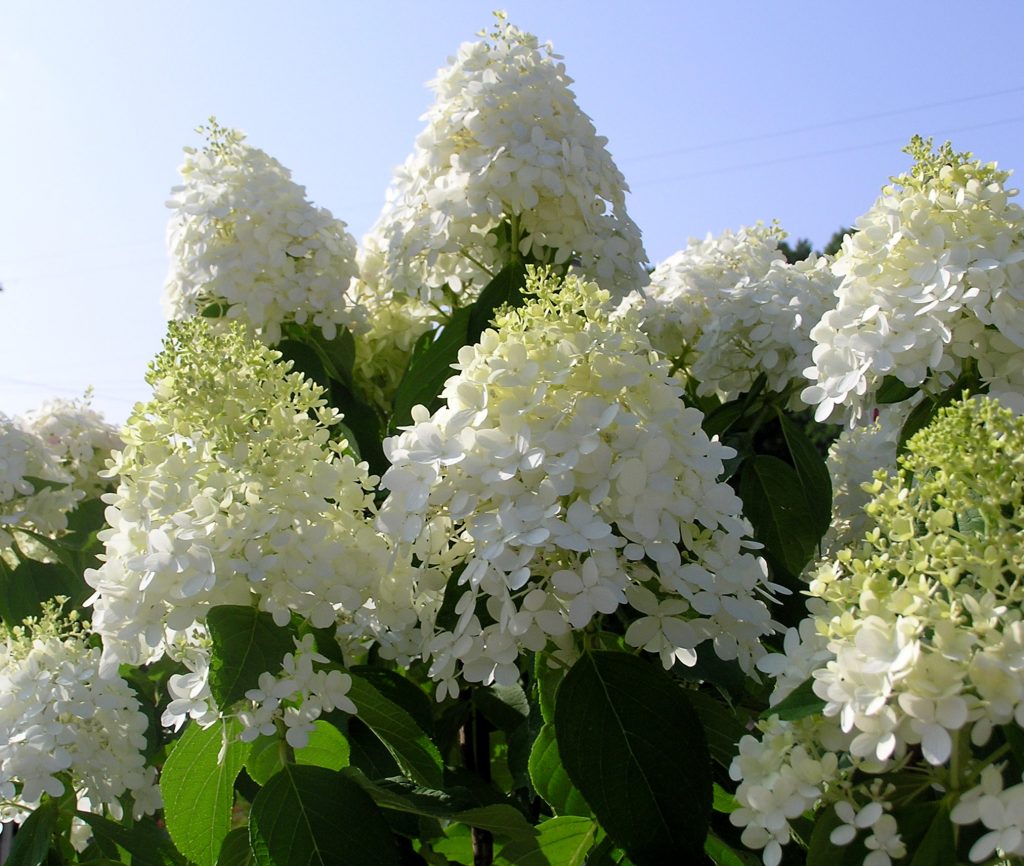
Hydrangea dolly photo
The main thing is that the needs for lighting, moisture and acidity of the soil of the neighbors on the mixborder coincide.
Dolly is often planted as a hedge - at the entrance to a house or yard, near gazebos, benches, the variety tolerates a haircut well, thanks to which you can give the bush any shape. Dolly looks very impressive in the form of a trunk.
Hydrangea paniculata has good resistance to polluted air. Therefore, it can be planted in city flower beds along busy roads.
On the lawn, Dolly is especially beautiful in combination with conifers, ornamental shrubs with contrasting foliage, and low annuals.
A hedge, together with delphiniums, will not only divide the site into zones, but will also become its undoubted decoration.
Variety reviews
Dolly is a favorite of many hydrangea owners. They appreciate it for its beauty and unobtrusive scent.
Flowers stand perfectly in cut, dried - retain their shape and extraordinary color. Needlewomen really like this.
Florists are interested in experiments with color: thanks to simple operations - feeding with a solution of aluminum alum (2 pcs per 8 l) or sulfate of iron, aluminum (20-40 g per bucket of water), both blue and pink inflorescences will begin to form on the shrub.
Landscape designers are happy to use Dolly hydrangea in garden compositions - compact inflorescences with rich color transitions create an excellent impression.
Novice and experienced growers note the ease of caring for this variety and the ability to quickly recover even in adverse climatic conditions.
Hydrangea Dolly is increasingly used by hobbyists and professional gardeners to decorate gardens of all sizes. It has many advantages and no disadvantages at all. Let the beauty come to your site!

